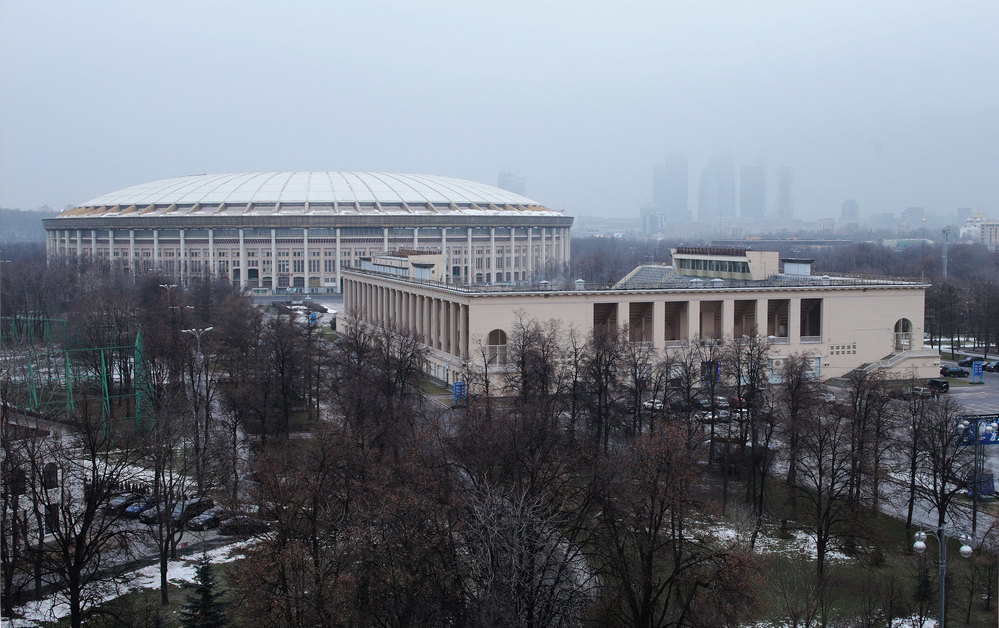Reconstruction of Luzhniki pool: rings, crystals, moss and scales

Finally the projects of the participants of the second stage of a national competition for the reconstruction of the pool at Luzhniki Stadium have been revealed. The portal of Archcouncil reviewed these projects with enthusiasm and analyzed where and why contemporary architecture is swimming.
“Past — present” in figures
Luzhniki pool was built in 1956 in the complex with the Central Stadium. At present, its technical features no longer meet the requirements of international sports federations and need a major upgrade. Reconstruction pertains not only to the pool building itself, but also the entire land plot of 3.48 hectares on which it is located.
To be clear, we are talking about a territory of more than one and a half times the size of Winzavod Contemporary Art Center.
Tasks of the competition included the creation of a 20 m wide pedestrian area around the pool, a 1000 sq m square in front of the main entrance, and a 45 m pedestrian alley leading to the Vorobyevy Gory metro station.
Currently, the total area of the pool building is 26,000 sq m. At the end of the planned works, it should be substantially increased — up to 42,000 sq m as a whole (this is not the policy, but rather the maximum allowable figures) and up to 32,000 sq m in the aboveground part (at the proposed total height of 26 m). As projected by the management of Luzhniki the total surface area of water in the pool is to increase from 2000 sq m to 6000 sq m.
.jpg)
“Past — present”: stylistic aspects
Some elements of the pool building’s composition are recognized as historically valuable, so the north and south walls with colonnades, and the north-eastern wall with bas-reliefs were to be saved.
Generally speaking, the overall architectural design of the reconstructed complex should ensure the harmonious unity of the old and new parts, as well as with the entire ensemble of sports facilities in the Luzhniki Stadium.
At the same time, the project brief specified the need to use modern high quality materials and constructions. The authors were instructed to provide for the possibility of a covering for the main, and sports and fitness, areas of the pool with a mobile translucent roof.
Only ours!
The competition was national, not international. Therefore, the right to participate in it was received by Russian design firms and representative offices of foreign companies, as well as domestic architectural firms leading consortiums with foreign firms. The composition of the jury chaired by Vladimir Plotkin (Reserve) included the chief architect of Moscow — Sergey Kuznetsov, head of the Department of Cultural Heritage of Moscow — Alexander Kibovsky, chief architect of the Research and Design Institute of the General Plan of Moscow — Andrei Gnezdilov, as well as well-known Moscow architects Dmitry Barkhin, Nikolai Lyashenko, Sergei Tchoban and Nikolai Shumakov, partner of KB Strelka — Alexei Muratov and three representatives each from the customer and the organizer.
Open selection of finalists was carried out on the basis of the conceptual design and analysis of the participants’ portfolio. The results were announced on January 25.
Out of the 19 project proposals from 43 registered participants the jury selected 6 concepts worthy of detailed elaboration in the second stage of the competition. Upon its completion on April 29, the jury went over the final results, and on June 2 all 6 projects were presented to the public, including the 3 finalists. UNK project (first place), consortium of ARENA Design Institute of Unique Structure + LANIK (second place) and A-B Studio (third place in the ranking), Arch Group, DNK architectural group and Asadov Architectural Studio.
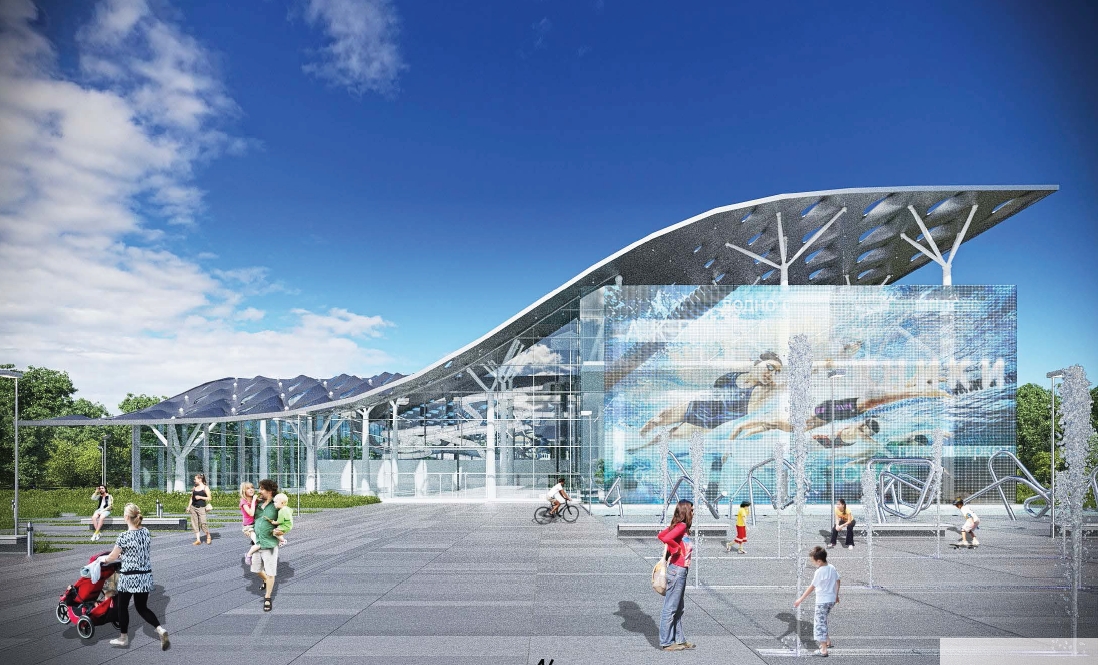
“Dragon Scales”
The main feature of the project presented by Arch Group was an expressive blue curved roof, significantly in contrast with the appearance of the neighboring main sports arena of Luzhniki. The roof resembles a wavy surface of the sea with a coral reef and is designed for the viewer’s perception from afar, from Vorobyevy Gory, from Komsomolskaya prospekt and the metro bridge.
Up close its raised outlines, according to the authors, are likened to the scales of a fairytale sea dragon. At the same time on three sides, they are almost invisible: the architects kept the old walls of all facades except the southeast, and the space between them is filled with a rectangular glass volume. This volume is intended as a neutral background for the “futuristic” roof, and for the historical structural and decorative elements.

The main facade facing the road and metro station is especially impressive: its design is supplemented with a side media screen.
The territory is landscaped, and it is suggested to plant trees inside the building as well. The roof has 3 glazed openings, and sections of the glass volume’s facades also can be opened. After already surveying the water park from the outside, the interior is an intricate space with slides, beaches, islands, a “river,” a waterfall, and an aquarium with fish and algae.
“Inverted Bowl”

DNK architectural group chose a different point of view, arranging a visual image of the new water sports center, focusing primarily on how it will look from the observation deck on Voryobyevy Gory. The light-colored, large-scale symmetric volume visually echoes the big arenas and stadiums built for the 1980 Olympics, and oddly enough, even compositionally connects these two seemingly very different structures.
The resulting building is a bit extravagantly monumental, akin to late-soviet Central Asian museums.

The enclosure of the huge “inverted bowl,” surrounded by the historical facades, is formed of a supporting lattice steel structure and the edge of the cantilever overhangs over the indoor public lobby protruding from under them. A considerable part (15%) of panels facing the “bowl” is designed to be transparent. Some heaviness of the building is emphasized by an impressive enclosure thickness (1.8 m) and siding (1.5 m), however in contrast, the lighting of the complex at night creates an effect of lightness and a flooding of a “sea of lights.”

Compositional interior accents are to be water park space of differing heights and the main swimming pool is to be covered with translucent lights. The roof over them, as in the previous project, can be moved apart.
Moss on the facades and a spa on the roof
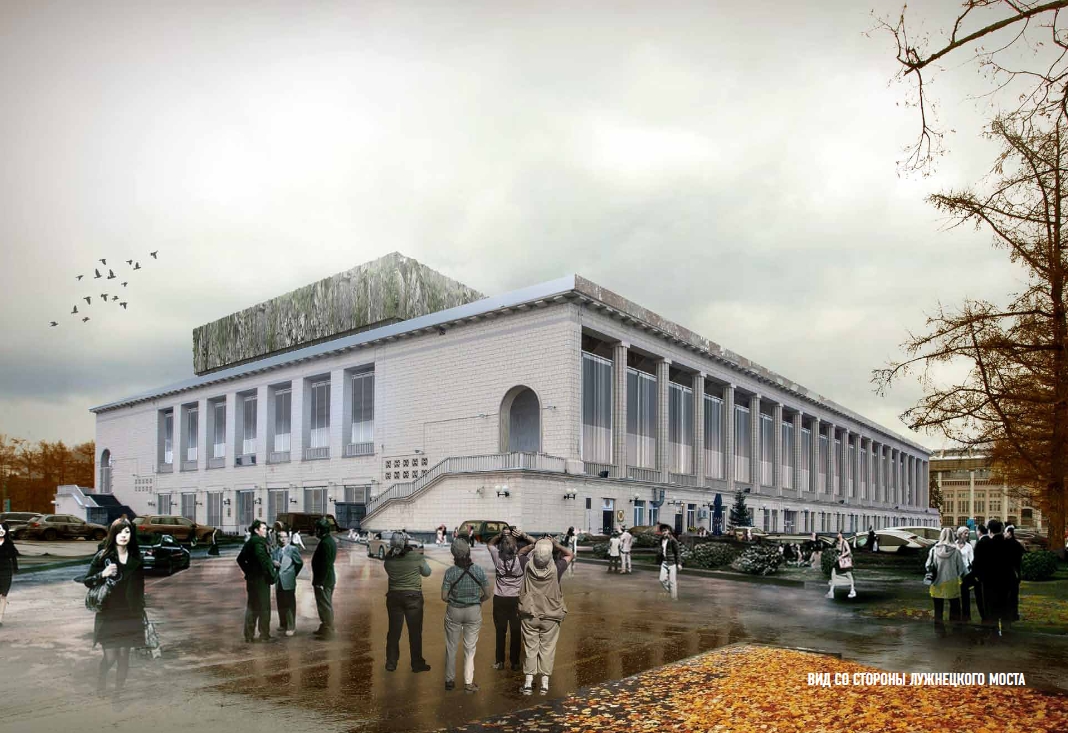
Authors of the concept by Asadov Architectural Studio describe their project as follows: “in the existing classical peripter, an elongated rectangular block is inserted — a „case“ with new features. Strict geometry of the classical architecture is complemented by the uneven surface of the new volume, consisting as though of layers of earth and pierced with slits of window openings.
Special treatment of the facade creates a breeding ground for moss and lichen, gradually covering the „case“ with a green carpet.
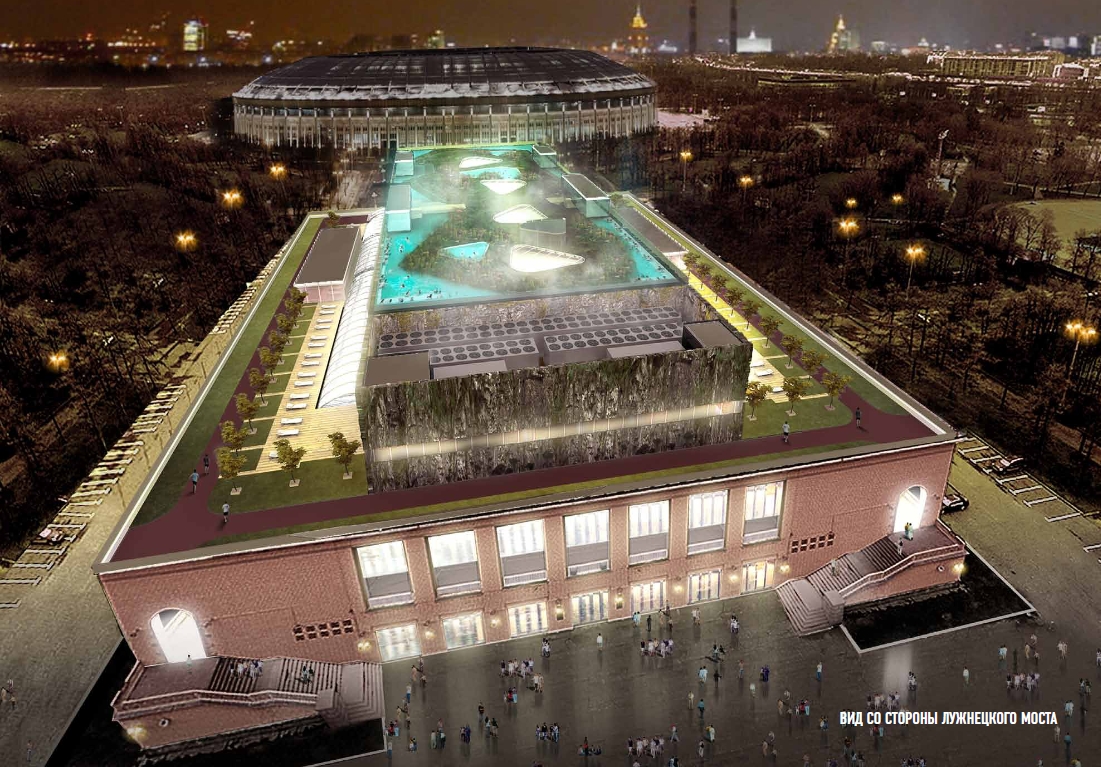
On the roof of the „case“ is an eco-spa area, like a „lost world“ in the center of Moscow. In the middle part of the roof, carved from the edges of the water surface, among the picturesque vegetation, various baths with thermal waters and Jacuzzis are placed. The interior space continues the theme of a „lost world„ — with water-loving plants and all sorts of water sports.“
As conceived by Andrey Asadov and his colleagues, the most spectacular perspective for viewing the reconstructed complex should be from the Grand Arena: planned in the northwestern part of the building is an outdoor terrace for summer concerts, located under a large cantilever overhanging from the green rectangular block.
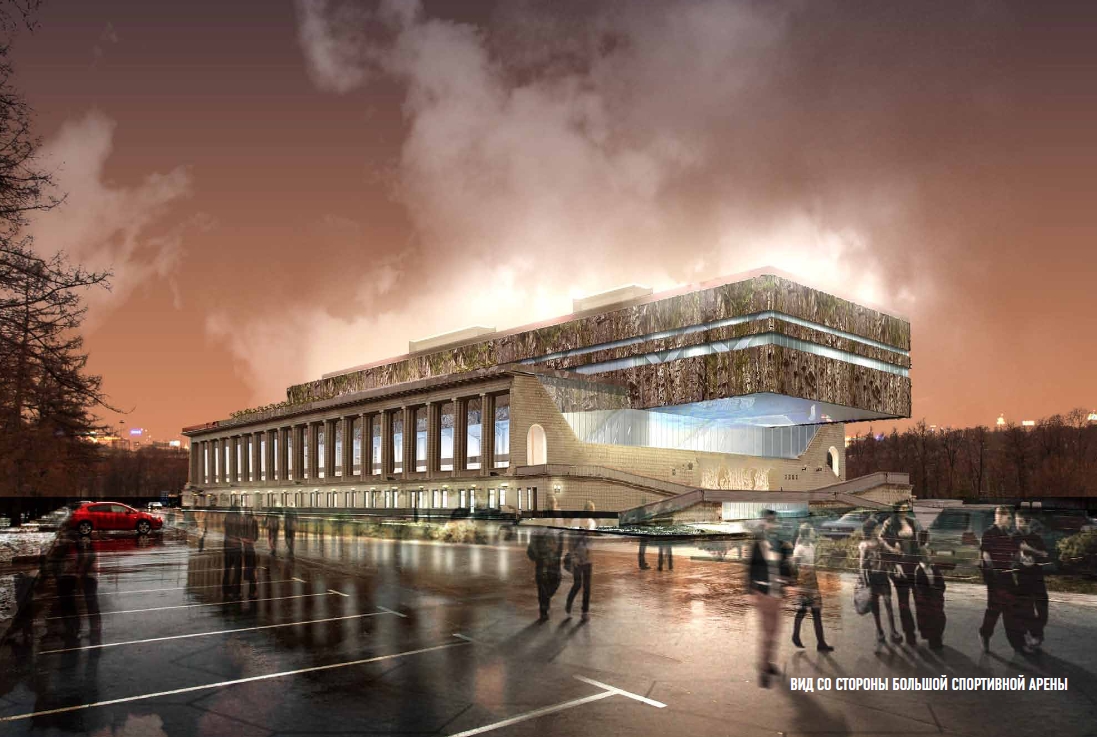
An interesting „plus“ of this project is the creation of an emphasized favorable background for the audience’s perception of the retained historic facades. When viewed from below, the new elements of the composition unconditionally subordinate to the old walls and colonnades, but looking from a panoramic view from distant points an unprecedented in Moscow artificial lake with landscaped islands on the roof catches the eye.
„Media Pool“

The concept that received third place was named by the authors, „Media Pool.“ As stated in the explanatory note of the project, the volume of the building was decided to be transformed into a likeness of a huge white luminous sculpture with maximally transparent indents in the panoramic glazing. Facades and interior walls will look like a kaleidoscope of screens situated vertically or at an angle to the ground. And on each one light graphics of various formats will be projected!
Despite the restrained elements of „deconstruction,“ the new volume is basically strictly rectangular. Monumentally towering over the walls from 1956, from afar it reminds of quality examples of Soviet architecture of the ’60s, especially from the main facade, facing the Grand Arena.
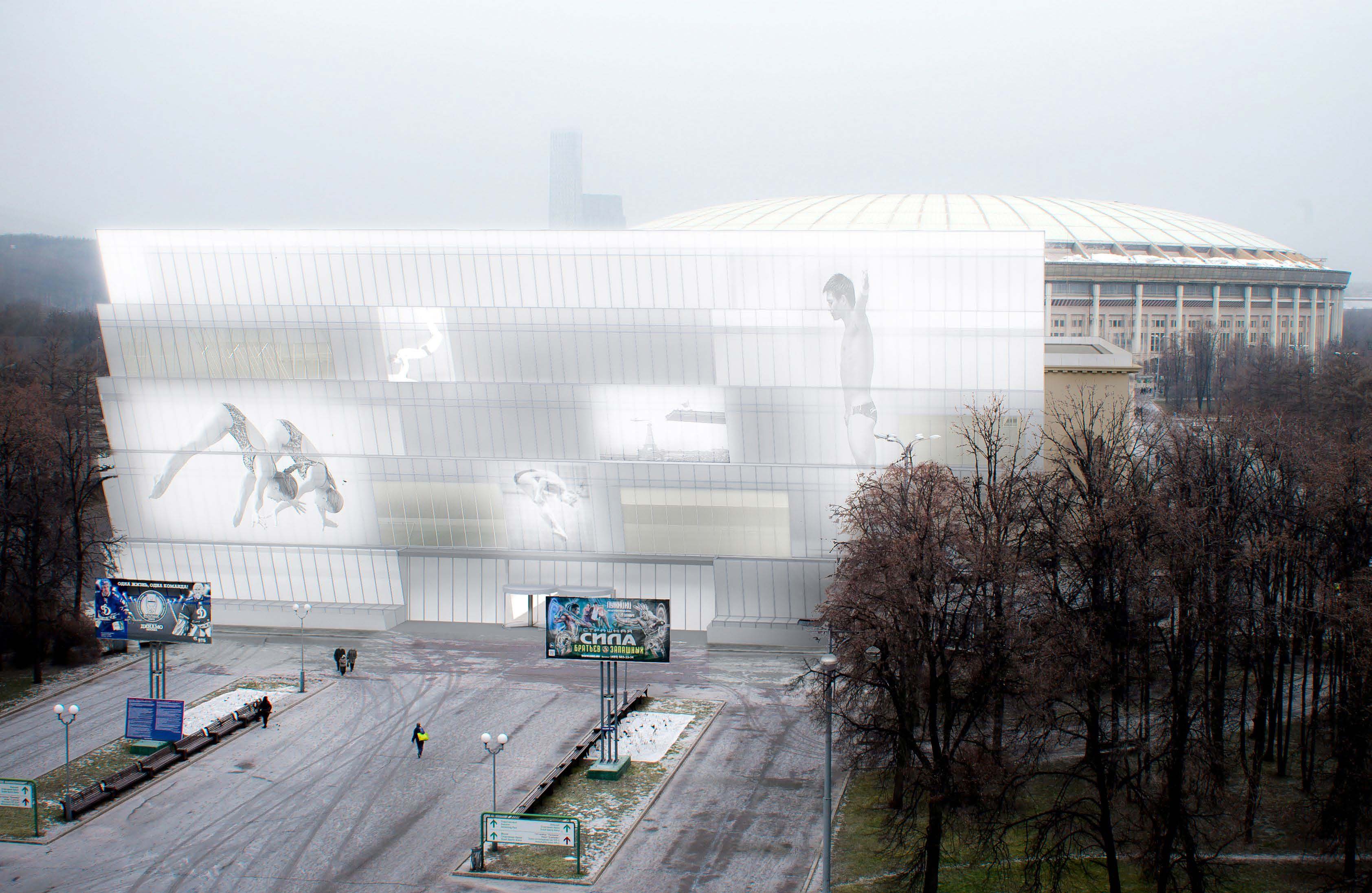
The wide cantilevered canopy over the open part of the pool and the platforms in the form of a rectangular plate with transverse rows of small round fixtures evoke the Rossiya cinema and the Kremlin Palace of Congresses. It’s as though the authors are restoring the lost link in historical continuity.
At the same time, plenty of lighting effects thought up by the architects including the regular change of color of the night lighting, makes the proposed A-B Studio variant of the transformation of the Luzhniki water sports complex pronouncedly contemporary.
„Openwork Palace“
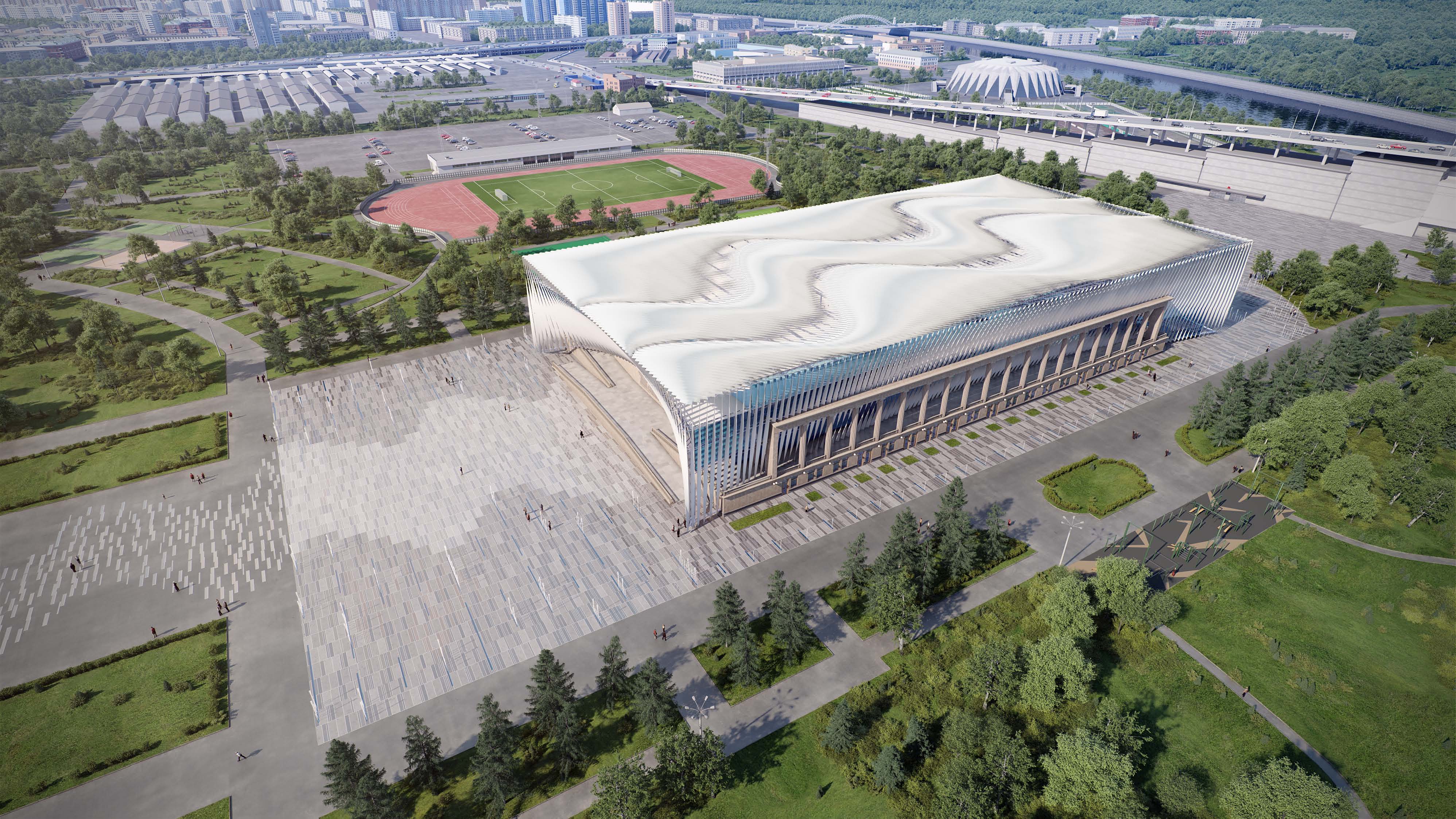
The project of the consortium of ARENA + LANIK also provides a traditional rectangular base configuration embedded in the old walls of the main volume. Admittedly, in this case the details are essential. As stated in the explanatory note, “elastic sweeping depressions of transparent glass of the facade planes is supplemented with a „shimmering„ rippled structure of the outer surface formed by a layer of semi-transparent wavy segments, that gives the building an appearance of fluidity and hints at its connectivity with the element of water.“
Spirally twisted segments made of perforated metal also cover the roof together with the attached elements of the technical infrastructure.
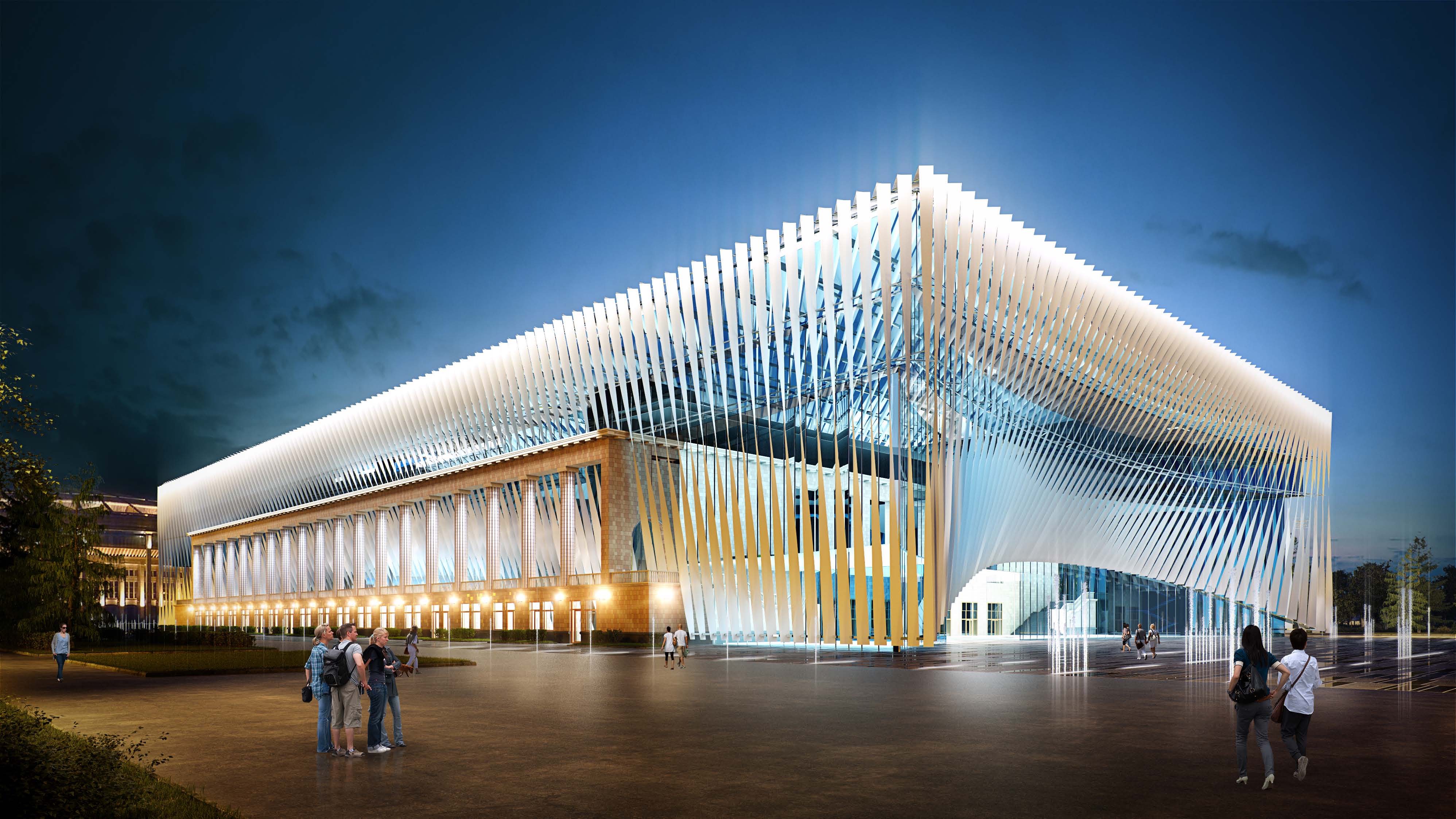
The main entrance, in this case from the road to the Vorobyevy Gory metro station, is accentuated by an asymmetrical smooth arc across the entire width of the facade. The building clearly fits into the typological array of openwork „palaces“ for public purposes, especially those which, beginning with the 19th century, were regularly built for world exhibitions.
The interior has very distinct motifs of „crystallinity,“ reminiscent of ice and snow.
Lighting of the building, in accordance with the technical requirements, is designed in multiple variations: usually smooth and uniform, it can vary dramatically. Playing a special role in the implementation of lighting scenarios are the color-dynamic lamps that are integrated into the paving area for the illumination of fountains.
„Ringed Era“

The winning project by UNK Project headed by Yuliy Borisov is very different from the work of all the other participants in the second stage of the competition. Most notably is the intention of the authors to give up all stylistic contrast between the architectural design of the historical elements of the building and the exterior of the newly created part.
The retained walls are integrated into one of the two stacked one above the other rectangular volumes, with some reliefs transferred into the interior of the lower tier.
The upper tier and the core of the lower tier represent a single volume with an ornamentation of connected rings, accentuating the glazed facades.
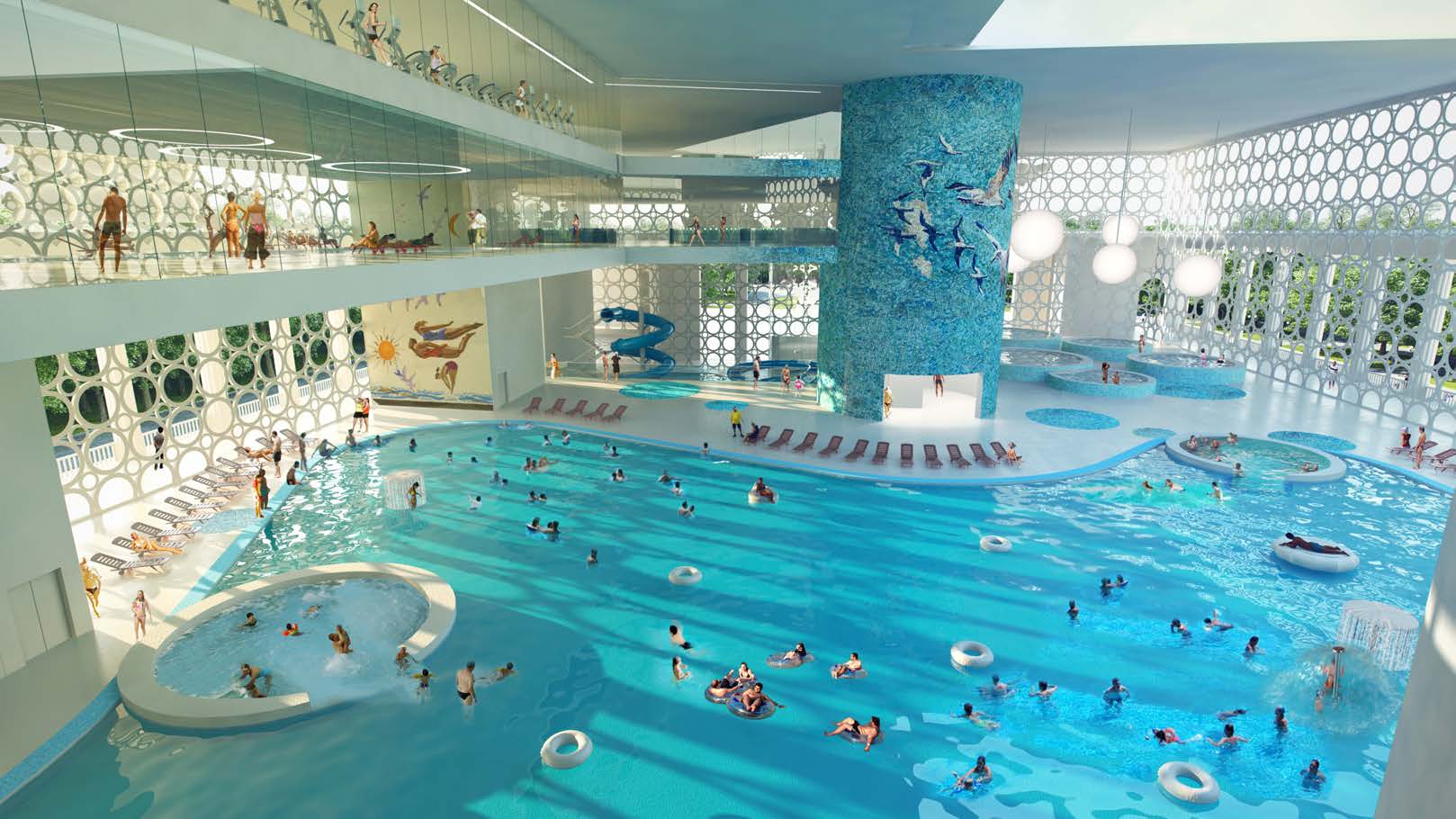
The crowning of the building is further embellished with large reliefs identical in style to the smaller authentic sculptural compositions of the 1950s. As pointed out by the architects, this solution is borrowed from the arsenal of expressive means used at the time by the creators of the original Luzhniki pool design.
The motif of rings, associated with the historical memory of the 1980 Olympics, on the eve of which the water sports complex was reconstructed for the first time, is also picked up in the interior decoration. In the treatment of large surfaces, mosaics made based on famous works of Alexander Deyneka are used.
Small architectural forms of the area around the building are also expected to be executed in the spirit of the period look of mid 20th century Soviet street design.

Background information
The open national competition to develop the architectural concept of the spatial arrangement of Luzhniki pool, conducted with the support of the Committee for Architecture and Urban Planning of Moscow, was announced six months ago, at the end of December 2013. The customer of the competition was JSC Luzhniki Olympic Complex, Codest International was the organizer, and “Aglomeracia” Center for Communication Technologies was the consultant. “Aglomeracia” under the contract with the customer, prepared all the necessary preliminary documents, including the materials for the jury meetings.
- Tags:
- competitions |
- sport |
- Luzhniki


